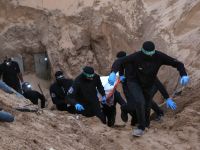It was in the year 1983 when the residents of the village of Tabah, east of Hail, discovered they had been living on a volcano crater for centuries.
The village, nestled in the Salma Mountains in northern Saudi Arabia, presented a perfect picture of peace and harmony. Villagers reported feeling tremors and seeing cracks in the ground here and there, but no one really thought much of it.
The situation worsened in the 1980s, when a development project began in the area and an asphalt company began paving roads, a process for which the village’s underground water had to be extracted.
من أجمل الاماكن السياحية في حائل فوهه بركان الهتيمة بالقرب من قريه طابه .. اللي حاب يزور المكان مرفق الاحداثيات بالصورة ..#السعودية #حائل #حائل_الآن #تراث #نقش #منحوت #السياحة #بركان #سياحة #اماكن pic.twitter.com/z79tX787bn
— شّعُور نّفسْ (@mutab_alenazi) August 28, 2020
The changes to the water table led to a series of loud sounds and land subsidence that destroyed several homes. It was then that the government decided to move the villagers to safety and compensate them by providing them with homes outside the volcanic zone.
Khalaf Naif Al-Hasher, 70, who was born in the old village of Tabah, told Arab News that it was an important and well-known part of northern Saudi Arabia and that its residents were known for their kindness and compassion.
“I remember very well the days when my relatives and I moved from Tabah after it began experiencing geological phenomena, such as tears, fissures and land subsidence,” he said.
“Although we did feel some tremors and saw slight cracks here and there, no one cared, and the village’s residents were not bothered by them.”
He said that moving to what he referred to as “the new Tabah” was urgent after several homes were damaged in the village, which had a population of 1,500 people at the time.
“The asphalt company used to consume large quantities of underground water, for which Tabah was famous, and the residents used to sell water to the company.”
Al-Hasher said that he and others who were present in those days still remember the terrifying sound that emanated from the ground.
“Everyone felt the strength and intensity of the tremors, which led to land subsidence,” he said. “Those houses with cracks still exist.”
Al-Hasher said that the Saudi government intervened in a timely manner, and its agencies acted quickly and inspected 250 damaged homes. The government then decided to move all residents to another residential area about 3 kilometers from the old Tabah and outside the volcanic zone.
Hamad Al-Mawkaa, a 57-year-old man who lived in Tabah, told Arab News that the village began to see large cracks more than three decades ago. He said the situation worsened when the underground water, which villagers had previously only consumed in small quantities for drinking and irrigation, was depleted due to the project.
“In a few days, all the groundwater reserves were emptied, and the village was unable to compensate for the lost water due to the scarcity of rain. This caused an imbalance in the earth’s crust, which led to a series of cracks and fissures that spread throughout the village,” Al-Mawkaa recalled.
This article has been adapted from its original source.








